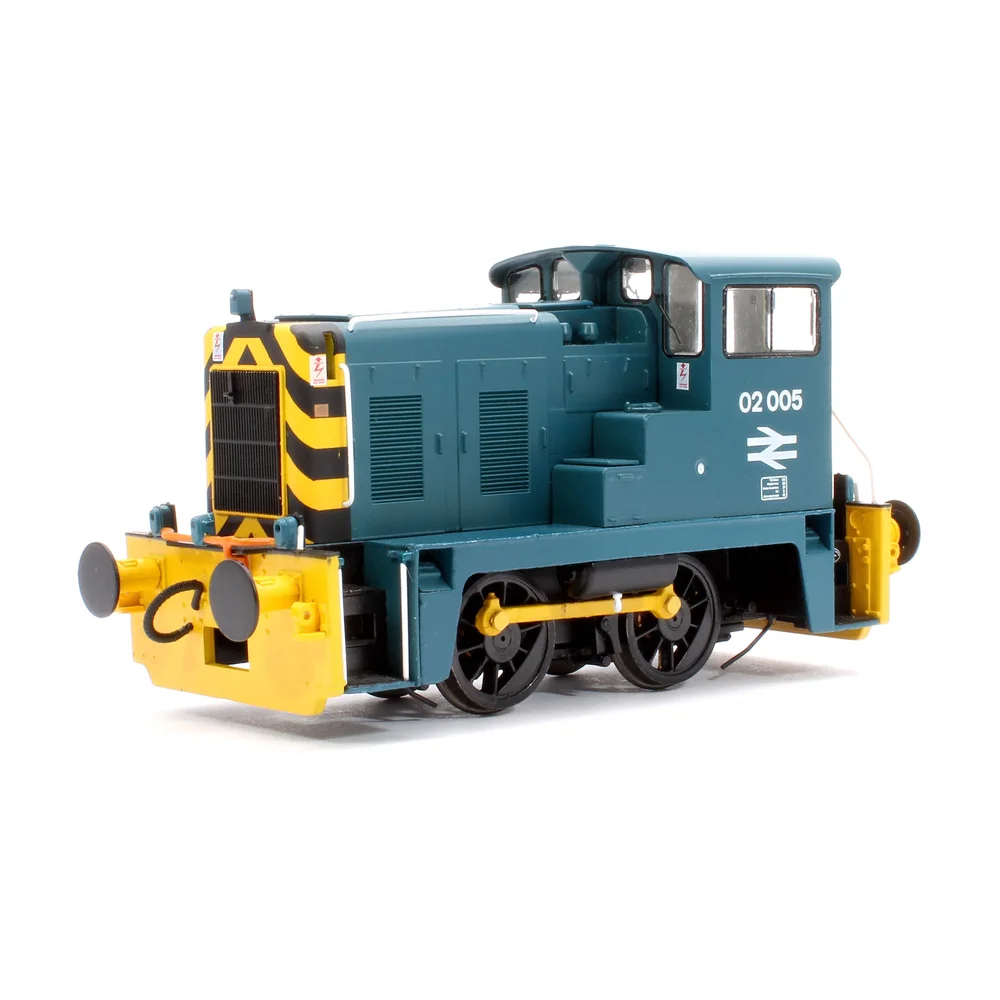Gaugemaster GM4240402
British Rail Class 02 02005 British Rail Blue
Tooling
Heljan’s OO gauge model of the British Rail Class 02 0-4-0 diesel-hydraulic shunter was announced as part of their 2024 range and delivered to retailers in early 2025. The prototype locomotives were built by the Yorkshire Engine Company between 1960 and 1961 for dockside and yard duties in areas with tight curves, primarily in the Liverpool and Manchester regions. With only 20 built, these diminutive shunters became a distinctive part of BR’s London Midland Region and later found extended service in industry and preservation. Heljan’s tooling fills a long-standing gap for ready-to-run models of this class in OO gauge.
Tooling Features
- Scale & Construction: OO gauge (1:76), injection-moulded plastic body with a die-cast metal chassis for weight and stability.
- Detailing: Separately fitted fine wire handrails, etched radiator grilles, lamp irons, wipers, pipework, and detailed cab interior with painted controls and glazing.
- Couplings: NEM pockets with tension-lock couplers supplied; optional three-link coupling hooks and chains included for bufferbeam detailing.
- Finish: Precision-applied liveries with authentic lining, printed data panels, and weathered options on selected models.
Mechanical & Electrical
- Drive System: High-quality 5-pole motor with flywheel for smooth, quiet running and excellent low-speed control.
- Weighting: Die-cast chassis provides good traction for shunting duties.
- Minimum Radius: Compatible with 1st radius curves, ideal for compact layouts.
- Lighting: Directional LED marker lights and cab interior lighting; cab lights operable in DC mode via magnetic wand supplied.
DCC Capability
- Interface: DCC-ready with Next18 decoder socket.
- Sound: Provision for DCC sound installation; factory-fitted speaker included in most versions.
Liveries Produced
Initial releases cover a wide range of authentic and industrial schemes, including:
- BR Green (early and late variations, with red or yellow bufferbeams)
- BR Blue with wasp stripes
- Industrial Yellow with wasp stripes
- Industrial Green (‘SAM’, weathered)
- Redland Khaki (‘Diane’, Gaugemaster Collection)
Reviews & Commentary
Early reviews and social media feedback have praised the model for its superb detailing, smooth and quiet mechanism, and suitability for micro-layouts and shunting scenes. The inclusion of cab lighting and magnetic wand control in DC mode has been highlighted as a thoughtful feature. Some reviewers noted minor issues such as bent handrails on a few samples, but overall reception has been positive, with many considering it a “miniature marvel” for OO gauge enthusiasts.
Interesting Notes
- The prototype Class 02 locomotives were fitted with Rolls-Royce C6NFL engines and were designed to replace the L&Y ‘Pug’ steam shunters.
- Seven examples of the class survive in preservation, including D2860 at the National Railway Museum.
Heljan’s Class 02 tooling combines historical accuracy with modern digital compatibility, making it an attractive choice for modellers seeking a highly detailed, compact shunter for industrial or dockside layouts.
Class & Prototype
- Class: British Rail Class 02
- Traction: Diesel
- Transmission: Hydraulic
- Built: 1960-1961
- Total Built: 20
No prototype found.
Operator & Livery
- Operator: British Rail
- Livery: Blue
British Rail (1965-1997) transformed Britain's railways through revolutionary modernisation, introducing the iconic double arrow logo, Rail Blue livery, and business sectorisation. BR pioneered high-speed rail with the InterCity 125 and Advanced Passenger Train, electrified major routes, and created profitable divisions like InterCity and Network SouthEast. From steam succession through diesel and electric development to privatisation preparation, British Rail's diverse locomotive fleet, multiple livery schemes, and operational scenarios provide unparalleled variety for railway modellers across all scales and periods.
BR Blue, also known as Rail Blue or Monastral Blue, was introduced in 1965 as part of British Rail's comprehensive corporate identity overhaul that accompanied the rebranding from British Railways to British Rail. The colour was officially defined by British Standards BR28/6001 (airless spray finish) and BR28/5321 (brush finish), representing a dark, greyish blue tone specifically chosen to hide dirt and weathering effects well.
The livery was prototyped on the experimental XP64 train in 1964 before becoming the standard scheme from 1 January 1965. Rail Blue was applied to all diesel and electric locomotives with yellow warning panels (initially small, then extending to full yellow ends from 1966). The standardised application included the iconic double arrow logo and Rail Alphabet typeface, creating one of the most successful transport corporate identities of the 20th century.
The livery dominated British Rail operations for over two decades until sectorisation in the 1980s began fragmenting the unified appearance. Despite initial colour fading problems in early applications, these were resolved by the late 1970s when the Large Logo variant was introduced featuring extended yellow areas and full-height double arrow symbols. Rail Blue's enduring appeal among railway enthusiasts reflects its role as the definitive British Rail image during the organisation's most unified period.
